Spatial Analysis of Human Health Risk Due to Arsenic Exposure through Drinking Groundwater in Taiwan’s Pingtung Plain
Abstract
:1. Introduction
2. Materials and Methods
2.1. Study Area and Hydrogeology
2.2. Groundwater Samples
2.3. Geostatistical Approach
2.4. Human Health Risk Assessment
3. Results and Discussion
3.1. Spatial Distribution of Arsenic Concentrations
3.2. Spatial Arsenic Risk Assessment and Health Risk Implications
4. Conclusions
Author Contributions
Conflicts of Interest
References
- Serre, M.L.; Kolovos, A.; Christakos, G.; Modis, K. An application of the holistochastic human exposure methodology to naturally occurring arsenic in Bangladesh drinking water. Risk Anal. 2003, 23, 515–528. [Google Scholar] [CrossRef] [PubMed]
- Halder, D.; Bhowmick, S.; Biswas, A.; Chatterjee, D.; Nriagu, J.; Guha Mazumder, D.N.; Šlejkovec, Z.; Jacks, G.; Bhattacharya, P. Risk of arsenic exposure from drinking water and dietary components: Implications for risk management in rural Bengal. Environ. Sci. Technol. 2013, 47, 1120–1127. [Google Scholar] [CrossRef] [PubMed]
- Engel, R.R.; Smith, A.H. Arsenic in drinking water and mortality from vascular disease: An ecologic analysis in 30 counties in the United States. Arch. Environ. Health 1994, 49, 418–427. [Google Scholar] [CrossRef] [PubMed]
- Kim, D.; Miranda, M.L.; Tootoo, J.; Bradley, P.; Gelfand, A.E. Spatial modeling for groundwater arsenic levels in North Carolina. Environ. Sci. Technol. 2011, 45, 4824–4831. [Google Scholar] [CrossRef] [PubMed]
- Tseng, W.P.; Chu, H.M.; How, S.W.; Fong, J.M.; Lin, C.S.; Yeh, S. Prevalence of skin cancer in an endemic area of chronic arsenicism in Taiwan. J. Natl. Cancer Inst. 1968, 40, 453–463. [Google Scholar] [PubMed]
- Chen, C.J.; Kuo, T.L.; Wu, M.M. Arsenic and cancers. Lancet 1988, 1, 414–415. [Google Scholar] [CrossRef]
- Chen, C.J.; Chuang, Y.C.; Lin, T.M.; Wu, H.Y. Malignant neoplasma among residents of a blackfoot disease-endemic area in Taiwan: High arsenic artesian well water and cancers. Cancer Res. 1985, 45, 5895–5899. [Google Scholar] [PubMed]
- Chen, C.J.; Chuang, Y.C.; You, S.L.; Lin, T.M.; Wu, H.Y. A retrospective study on malignant neoplasms of bladder, lung and liver in blackfoot disease endemic area in Taiwan. Br. J. Cancer 1986, 53, 399–405. [Google Scholar] [CrossRef] [PubMed]
- Morales, K.H.; Ryan, L.; Kuo, T.L.; Wu, M.M.; Chen, C.J. Risk of internal cancers from arsenic in drinking water. Environ. Health Perspect. 2000, 108, 655–661. [Google Scholar] [CrossRef] [PubMed]
- Chen, C.J.; Hsu, L.I.; Wang, C.H.; Shih, W.L.; Hsu, Y.H.; Tseng, M.P.; Lin, Y.C.; Chou, W.L.; Chen, C.Y.; Lee, C.Y.; et al. Biomarkers of exposure, effect, and susceptibility of arsenic-induced health hazards in Taiwan. Toxicol. Appl. Pharmacol. 2005, 206, 198–206. [Google Scholar] [CrossRef] [PubMed]
- Hsueh, Y.M.; Cheng, G.S.; Wu, M.M.; Yu, H.S.; Kuo, T.L.; Chen, C.J. Multiple risk factors associated with arsenic-induced skin cancer: Effects of chronic liver disease and malnutritional status. Br. J. Cancer 1995, 71, 109–114. [Google Scholar] [CrossRef] [PubMed]
- World Health Organization (WHO). Environmental Health Criteria 18: Arsenic; WHO: Geneva, Switzerland, 1981. [Google Scholar]
- Agency for Toxic Substances and Disease Registry (ATSDR). Toxicological Profile for Arsenic, Update, Visited; Agency for Toxic Substances and Disease Registry, Public Health Service; U.S. Department of Health and Human Services: Washington, DC, USA, 1993.
- Berg, M.; Tran, H.C.; Nguyen, T.C.; Pham, H.V.; Schertenleib, R.; Giger, W. Arsenic contamination of groundwater and drinking water in Vietnam: A human health threat. Environ. Sci. Technol. 2001, 35, 2621–2626. [Google Scholar] [CrossRef] [PubMed]
- United States Environmental Protection Agency. Technical Fact Sheet: Final Rule for Arsenic in Drinking Water. Available online: https://nepis.epa.gov/Exe/ZyPdf.cgi?Dockey=20001XXE.txt (accessed on 11 January 2017).
- Han, B.C.; Jeng, W.L.; Hung, T.C.; Ling, Y.C.; Shieh, M.J.; Chien, L.C. Estimation of metal and organochlorine pesticide expo-sures and potential health threat by consumption of oysters in Taiwan. Environ. Pollut. 2000, 109, 147–156. [Google Scholar] [CrossRef]
- Liao, C.M.; Ling, M.P. Assessment of human health risks for arsenic bioaccumulation in tilapia (Oreochromis mossambicus) and large-scale mullet (Liza macrolepis) from blackfoot disease area in Taiwan. Arch. Environ. Contam. Toxicol. 2003, 45, 264–272. [Google Scholar] [CrossRef] [PubMed]
- Jang, C.S.; Liu, C.W.; Lin, K.H.; Huang, F.M.; Wang, S.W. Spatial analysis of potential carcinogenic risks associated with ingesting arsenic in aquacultural tilapia (Oreochromis mossambicus) in blackfoot disease hyperendemic areas. Environ. Sci. Technol. 2006, 40, 1707–1713. [Google Scholar] [CrossRef] [PubMed]
- Lee, J.J.; Jang, C.S.; Liang, C.P.; Liu, C.W. Assessing carcinogenic risks associated with ingesting arsenic in farmed smeltfish (Ayu, Plecoglossus altirelis) in aseniasis-endemic area of Taiwan. Sci Total Environ. 2008, 403, 68–79. [Google Scholar] [CrossRef] [PubMed]
- Lin, M.C.; Liao, C.M. Assessing the risks on human health associated with inorganic arsenic intake from groundwater-cultured milkfish in southwestern Taiwan. Food Chem. Toxicol. 2008, 46, 701–709. [Google Scholar] [CrossRef] [PubMed]
- Liang, C.P.; Jang, C.S.; Liu, C.W.; Lin, K.H.; Lin, M.C. An integrated GIS-based approach in assessing carcinogenic risks via food-chain exposure in arsenic-affected groundwater areas. Environ. Toxicol. 2010, 25, 113–123. [Google Scholar] [CrossRef] [PubMed]
- Liang, C.P.; Liu, C.W.; Jang, C.S.; Wang, S.W.; Lee, J.J. Assessing and managing the health risk due to ingestion of inorganic arsenic from fish and shellfish farmed in blackfoot disease areas for general Taiwanese. J. Hazard. Mater. 2011, 186, 622–628. [Google Scholar] [CrossRef] [PubMed]
- Liang, C.P.; Jang, C.S.; Chen, J.S.; Wang, S.W.; Lee, J.J.; Liu, C.W. Probabilistic health risk assessment for ingestion of seafood farmed in arsenic contaminated groundwater in Taiwan. Environ. Geochem. Health 2013, 35, 455–494. [Google Scholar] [CrossRef] [PubMed]
- Kar, S.; Maity, J.P.; Jean, J.S.; Liu, C.W.; Bundschuh, J.; Lu, H.Y. Health risks for human intake of aquacultural fish: Arsenic bioaccumulation and contamination. J. Environ. Sci. Health Part A 2011, 46, 1266–1273. [Google Scholar] [CrossRef] [PubMed]
- Ling, M.P.; Wu, C.H.; Chen, S.C.; Chen, W.Y.; Chio, C.P.; Cheng, Y.H.; Liao, C.M. Probabilistic frame-work for assessing the arsenic exposure risk from cooked fish consumption. Environ. Geochem. Health 2014, 36, 1115–1128. [Google Scholar] [CrossRef] [PubMed]
- Lee, J.J.; Jang, C.S.; Wang, S.W.; Liu, C.W. Evaluation of potential health risk of arsenic-affected groundwater using indicator kriging and dose response model. Sci. Total Environ. 2007, 384, 151–162. [Google Scholar] [CrossRef] [PubMed]
- Liang, C.P.; Wang, S.W.; Kao, Y.H.; Chen, J.S. Health risk assessment of groundwater arsenic pollution in Southern Taiwan. Environ. Geochem. Health 2016. [Google Scholar] [CrossRef] [PubMed]
- Central Geological Survey. Taiwan CGS (Central Geological Survey) Hydrogeological Survey Report of Pingtung Plain, Taiwan; Central Geological Survey: Taipei, Taiwan, 2002; pp. 97–142.
- Liu, C.W.; Wang, S.W.; Jang, C.S.; Lin, K.H. Occurrence of arsenic in groundwater of the Choshui river alluvial fan Taiwan. J. Environ. Qual. 2006, 35, 68–75. [Google Scholar] [CrossRef] [PubMed]
- Ting, C.S.; Zhou, Y.; de Vries, J.J.; Simmers, I. Development of a preliminary ground water flow model for water resources management in the Pingtung Plain, Taiwan. Ground Water 1998, 35, 20–36. [Google Scholar] [CrossRef]
- Agriculture Engineering Research Center. Survey, Analysis and Assessment of Groundwater Quality in Taiwan Areas in 2009; Ministry of Economic Affairs, Executive Yuan, Water Resources Agency: Taipei, Taiwan, 2009; pp. 100–102.
- Agriculture Engineering Research Center. Survey, Analysis and Assessment of Groundwater Quality of Taiwan in 2010; Ministry of Economic Affairs, Executive Yuan, Water Resources Agency: Taipei, Taiwan, 2010; pp. 151–158.
- Agriculture Engineering Research Center. Survey, Analysis and Assessment of Groundwater Quality of Taiwan in 2011; Ministry of Economic Affairs, Executive Yuan, Water Resources Agency: Taipei, Taiwan, 2011; pp. 191–203.
- Agriculture Engineering Research Center. Survey, Analysis and Assessment of Groundwater Quality of Taiwan in 2012–2014 (1/3); Ministry of Economic Affairs, Executive Yuan, Water Resources Agency: Taipei, Taiwan, 2012; pp. 85–101.
- Journel, A.G.; Huijbregts, C.J. Mining Geostatistics; Academic Press: San Diego, CA, USA, 1978. [Google Scholar]
- United States Environmental Protection Agency (U.S. EPA). Integrated Risk Information System (IRIS). Available online: https://cfpub.epa.gov/ncea/iris/iris_documents/documents/subst/0278_summary.pdf#nameddest=rfd (accessed on 11 January 2017).
- Integrated Risk Information System (IRIS). CASRN 7440-38-2 Arsenic, Inorganic; U.S. EPA: Washington, DC, USA, 1998.
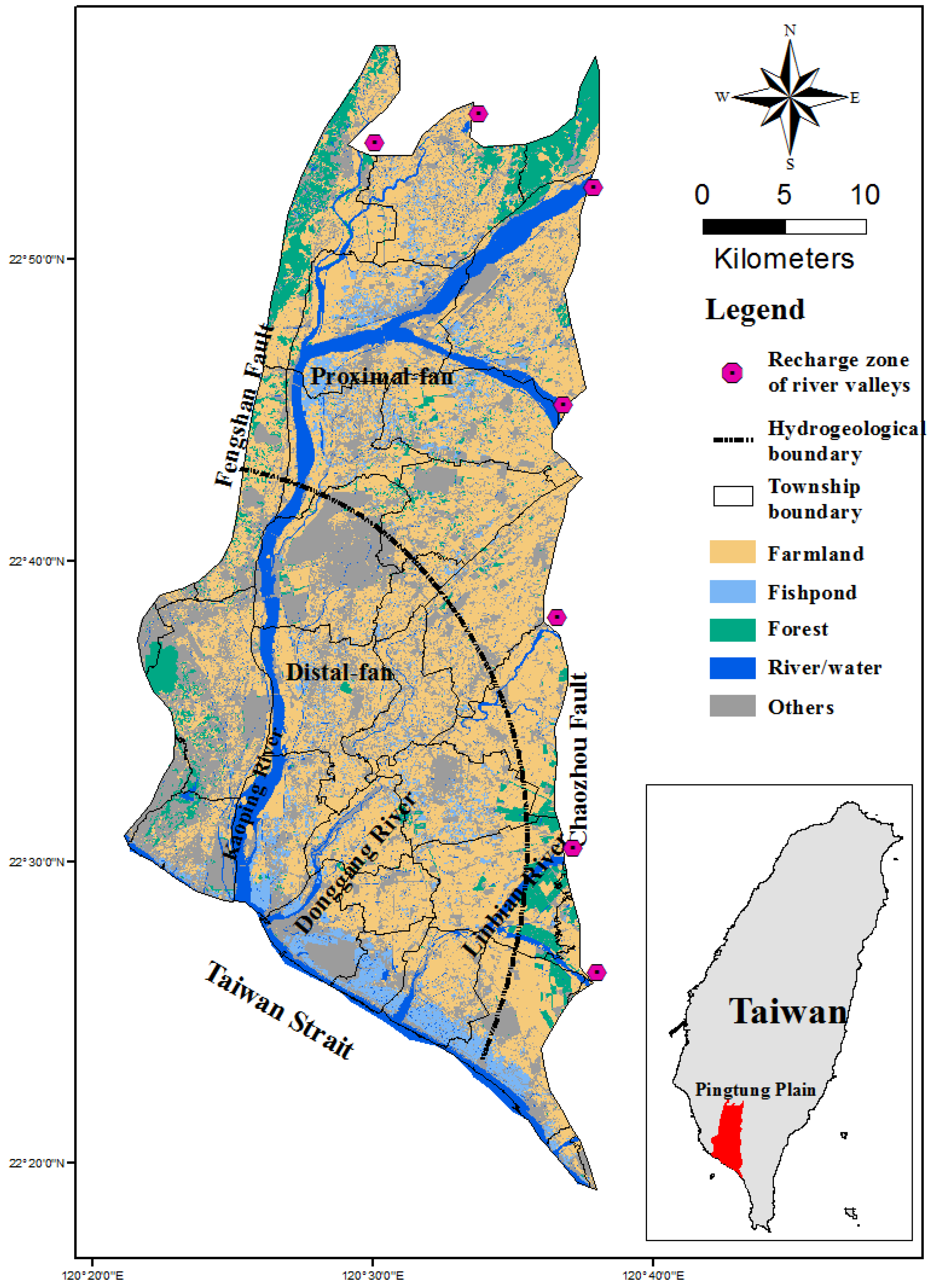


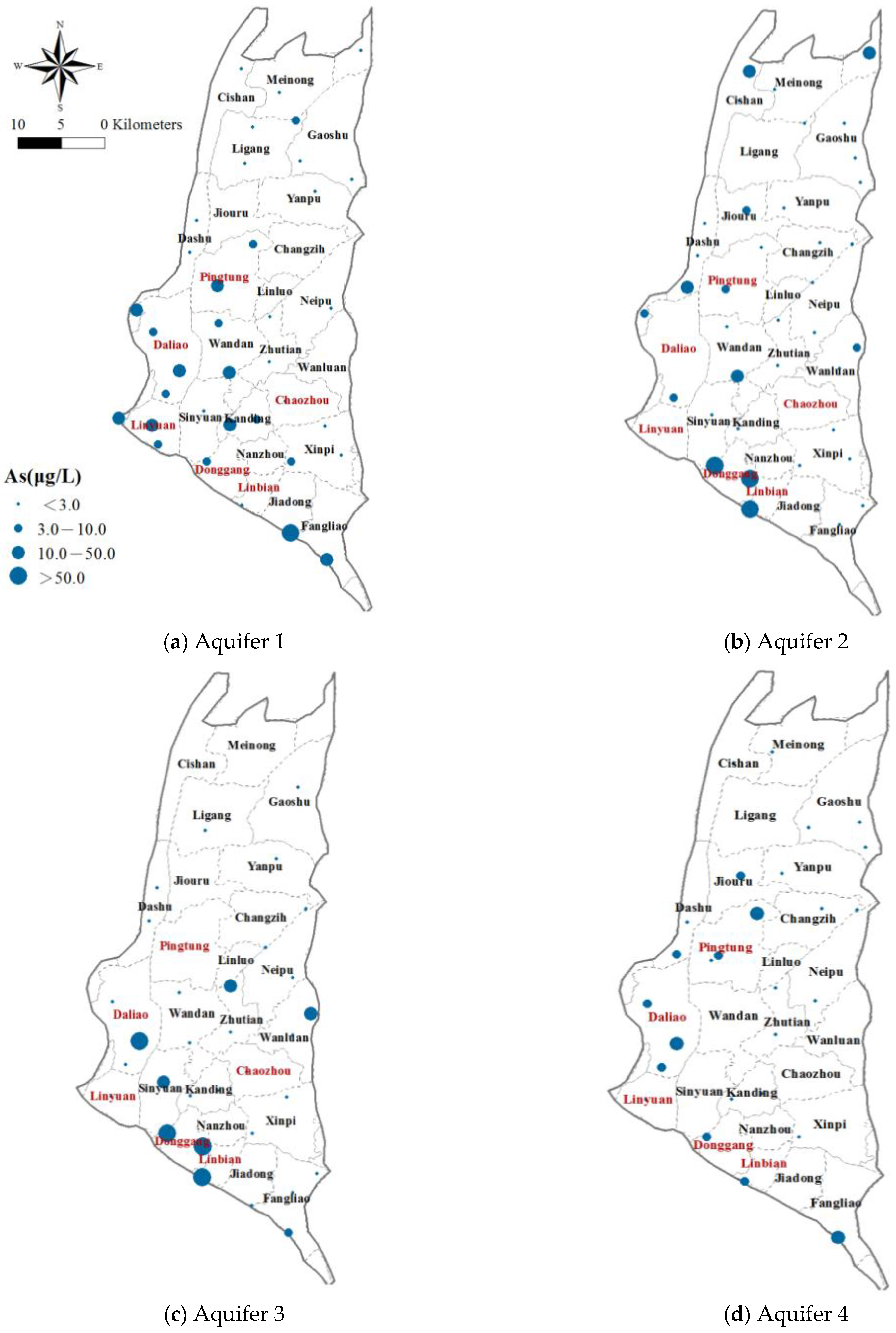
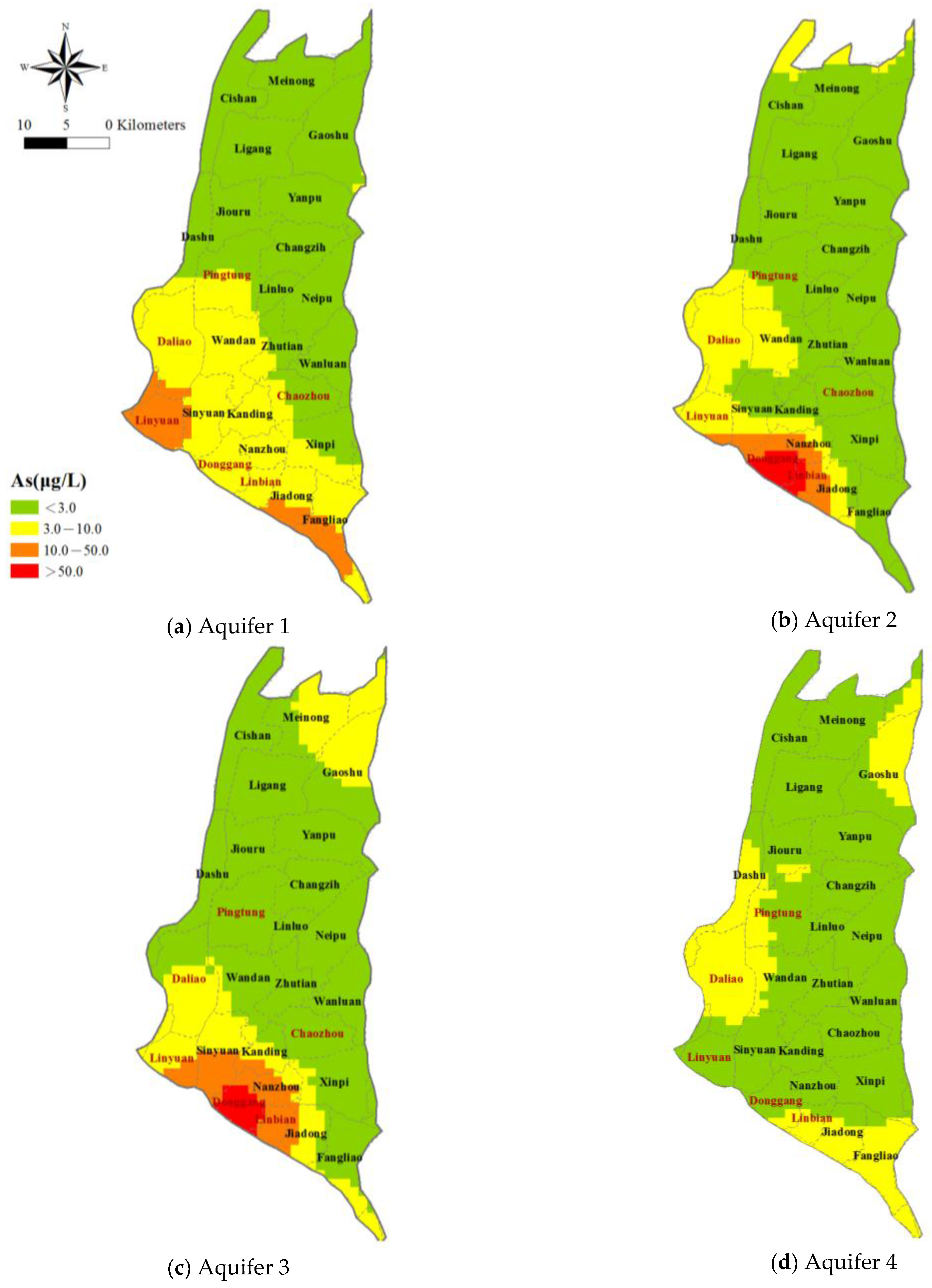

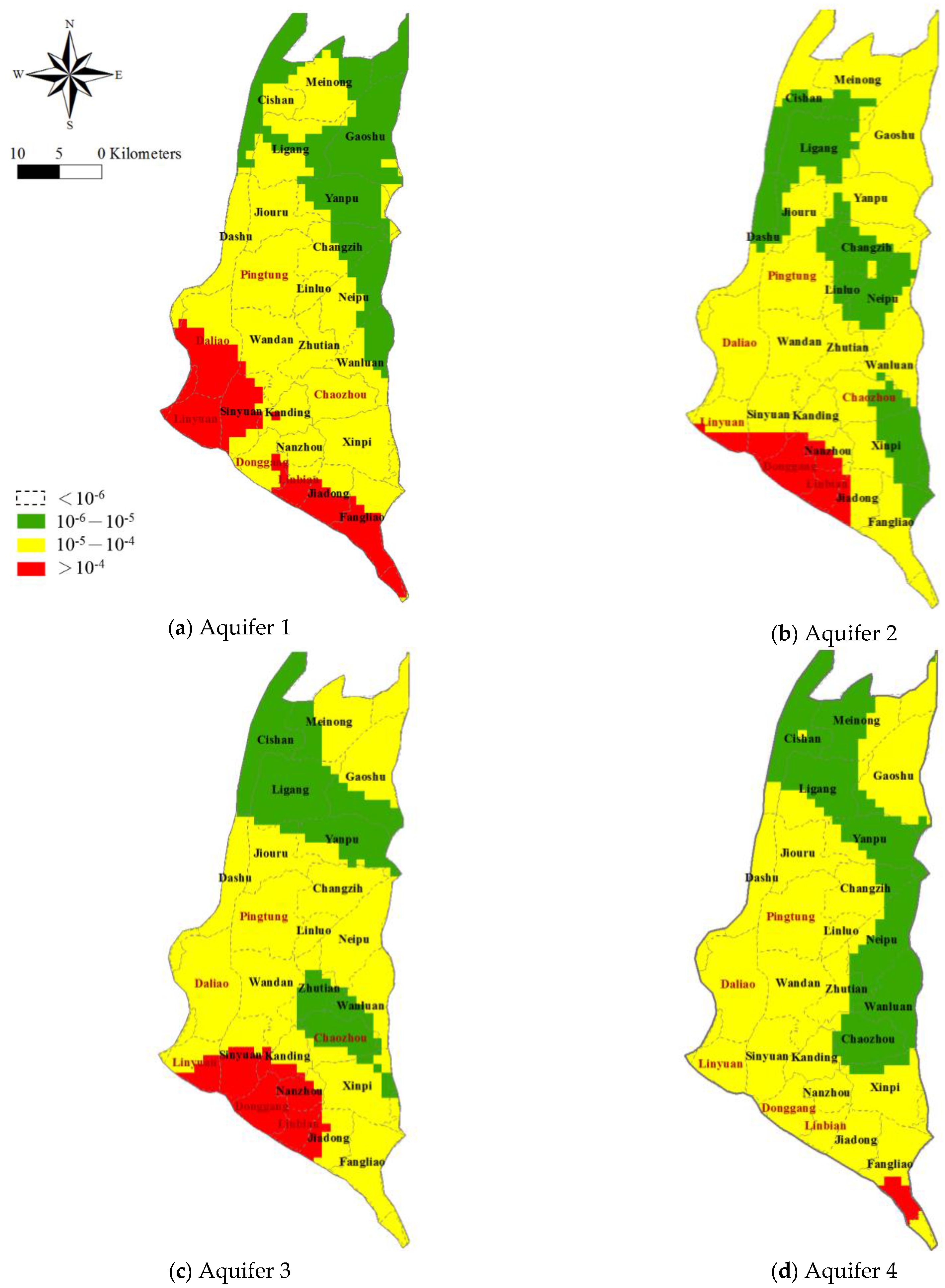
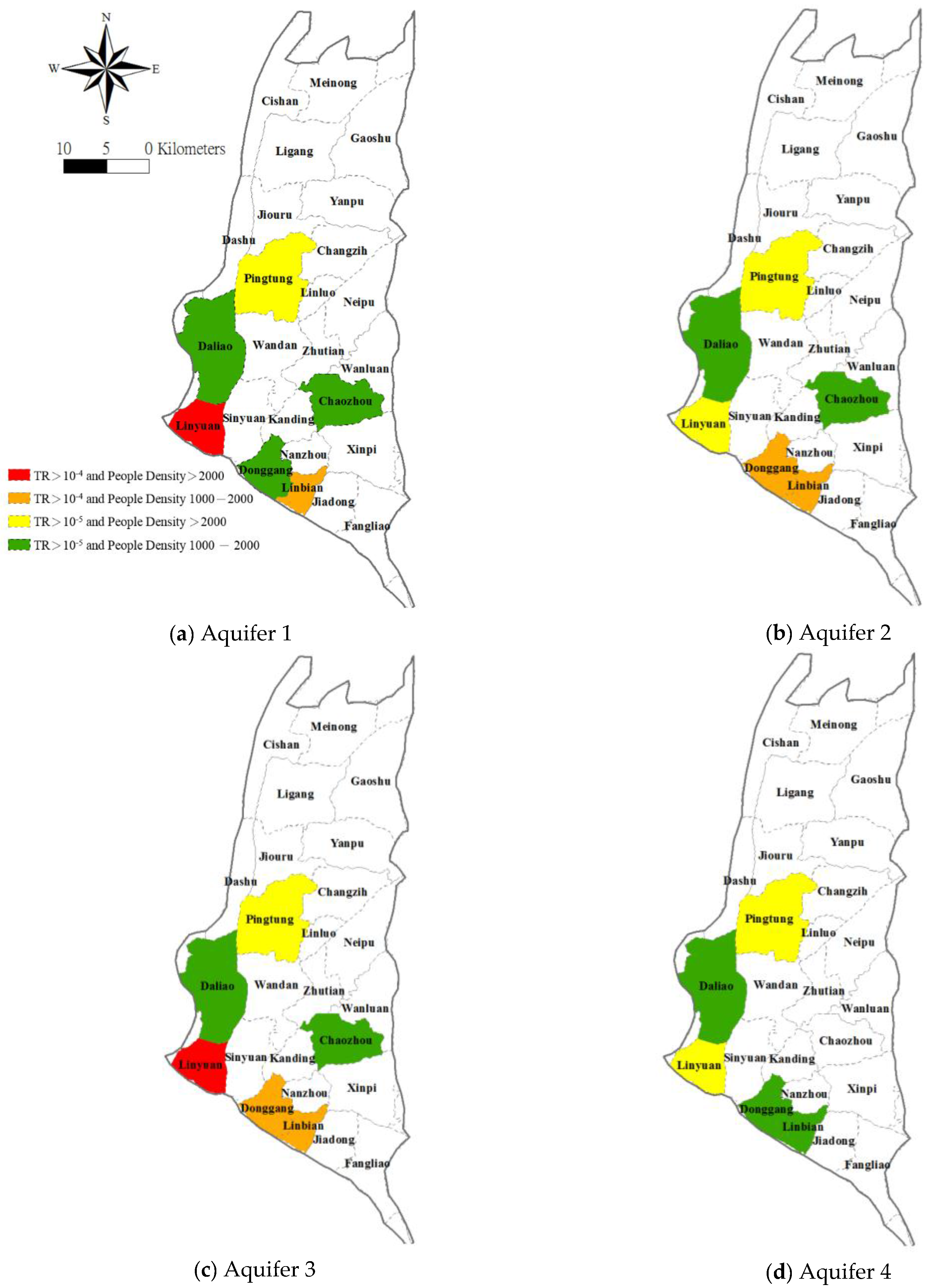
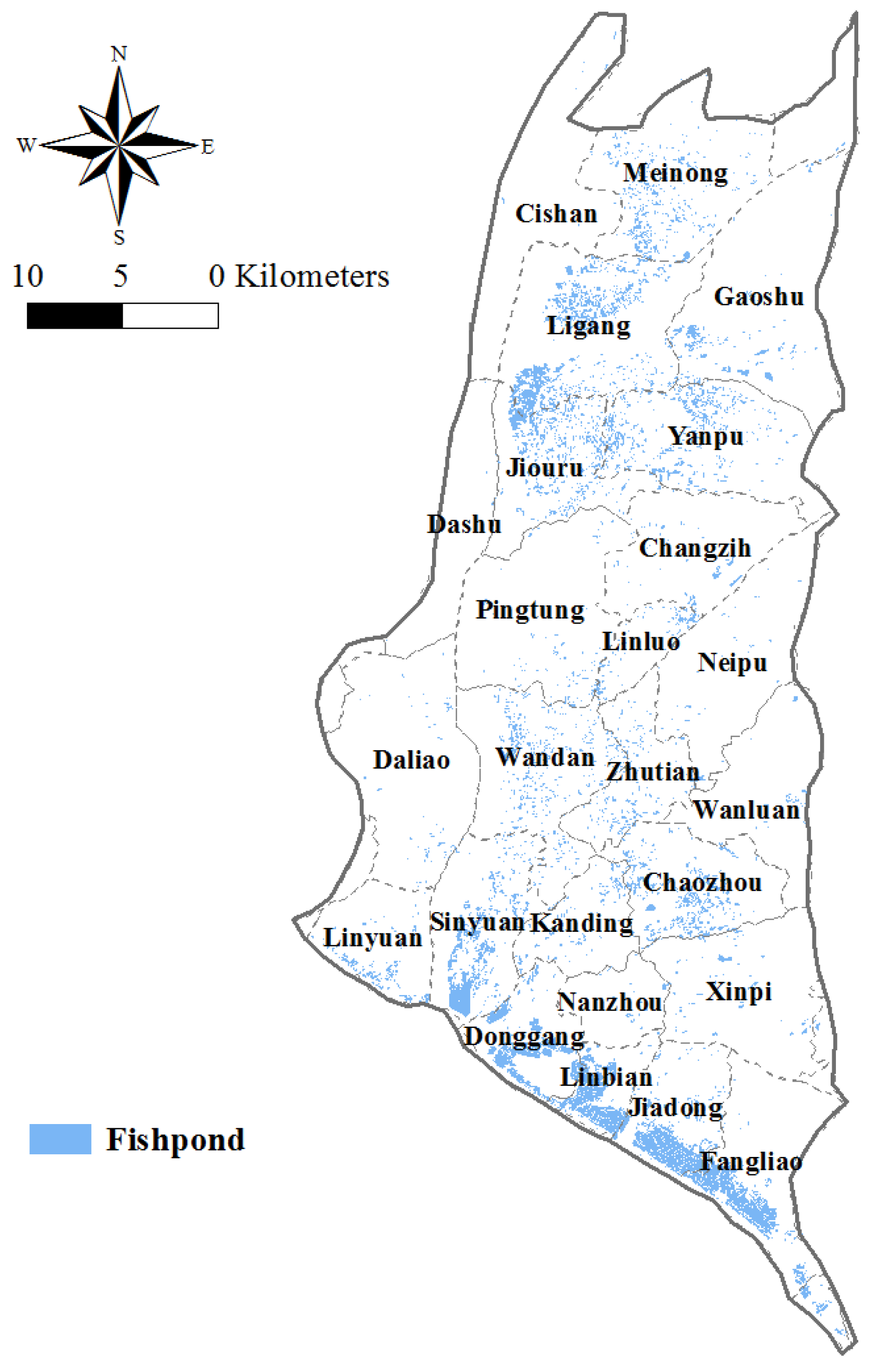
| Parameter (Unit) | Parameter Characteristics |
|---|---|
| ED (year) | 30 |
| EF (day) | 365 |
| IR (L/day) | 1.43 |
| BW (kg) | 64.6 |
| AT (day) | 79.0 × 365 = 28,835 |
| RfD (mg/kg/day) | 3 × 104 [35] |
| CSF (mg/kg/day)−1 | 1.50 [35] |
| C (μg/kg) | From groundwater quality monitoring data of Taiwan WRA |
| Statistics | As Concentration (µg/L) |
|---|---|
| Well number | 132 |
| Average | 18.1 |
| Median | 0.9 |
| Std. Deviation | 65.2 |
| Skewness | 5.8 |
| Minimum | <0.1 |
| Maximum | 544.0 |
| Percentiles | |
| 50th | 0.9 |
| 60th | 2.1 |
| 70th | 4.6 |
| 80th | 9.6 |
| 80.26th | 10.0 |
| 90th | 24.8 |
| Township | Population Density | Population | Area Percentage of TRs > 10−5 | Area Percentage of TRs > 10−4 | ||||||
|---|---|---|---|---|---|---|---|---|---|---|
| (Person/km2) | (Person) | F1 | F2 | F3 | F4 | F1 | F2 | F3 | F4 | |
| Pingtong | 3133.17 | 203,866 | 100.0% | 87.4% | 100.0% | 100.0% | 0.0% | 0.0% | 0.0% | 0.0% |
| Linyuan | 2182.87 | 70,476 | 100.0% | 100.0% | 100.0% | 100.0% | 100.0% | 34.0% | 42.6% | 0.0% |
| Donggang | 1638.03 | 48,262 | 100.0% | 100.0% | 100.0% | 100.0% | 13.6% | 93.2% | 100.0% | 0.0% |
| Daliao | 1565.19 | 111,191 | 85.7% | 85.7% | 85.7% | 85.7% | 34.7% | 0.0% | 0.0% | 0.0% |
| Chaozhou | 1289.98 | 54,738 | 100.0% | 71.7% | 30.0% | 20.0% | 0.0% | 0.0% | 0.0% | 0.0% |
| Linbian | 1231.17 | 19,235 | 100.0% | 100.0% | 100.0% | 100.0% | 55.2% | 89.7% | 96.6% | 0.0% |
| Sinyuan | 957.74 | 36,692 | 100.0% | 100.0% | 100.0% | 100.0% | 65.2% | 30.3% | 54.6% | 0.0% |
| Wandan | 906.33 | 52,085 | 100.0% | 100.0% | 96.6% | 100.0% | 5.7% | 0.0% | 0.0% | 0.0% |
| Changzih | 762.90 | 30,429 | 53.7% | 43.3% | 94.0% | 70.2% | 0.0% | 0.0% | 0.0% | 0.0% |
| Linluo | 695.76 | 11,313 | 100.0% | 42.3% | 100.0% | 100.0% | 0.0% | 0.0% | 0.0% | 0.0% |
| Neipu | 685.94 | 56,148 | 56.8% | 45.5% | 92.1% | 23.9% | 0.0% | 0.0% | 0.0% | 0.0% |
| Jiadong | 653.46 | 20,247 | 100.0% | 100.0% | 100.0% | 100.0% | 62.5% | 35.4% | 39.6% | 0.0% |
| Dashu | 644.81 | 43,190 | 98.2% | 40.0% | 96.4% | 100.0% | 0.0% | 0.0% | 0.0% | 0.0% |
| Zhutian | 609.46 | 17,719 | 100.0% | 92.3% | 57.7% | 82.7% | 0.0% | 0.0% | 0.0% | 0.0% |
| Nanzhou | 581.23 | 11,026 | 100.0% | 100.0% | 100.0% | 100.0% | 3.0% | 48.5% | 72.7% | 0.0% |
| Jiouru | 527.67 | 22,172 | 83.1% | 49.4% | 71.4% | 84.4% | 0.0% | 0.0% | 0.0% | 0.0% |
| Kanding | 523.70 | 16,374 | 97.6% | 97.6% | 90.5% | 90.5% | 7.1% | 7.1% | 33.3% | 0.0% |
| Fangliao | 441.36 | 25,482 | 98.7% | 75.3% | 98.7% | 98.7% | 42.9% | 0.0% | 0.0% | 14.3% |
| Yanpu | 413.82 | 26,629 | 27.9% | 87.3% | 26.6% | 30.4% | 0.0% | 0.0% | 0.0% | 0.0% |
| Cishan | 402.70 | 38,100 | 30.7% | 59.1% | 1.1% | 11.4% | 0.0% | 0.0% | 0.0% | 0.0% |
| Ligang | 389.06 | 26,814 | 52.1% | 18.8% | 7.3% | 26.0% | 0.0% | 0.0% | 0.0% | 0.0% |
| Wanluan | 344.43 | 20,918 | 55.7% | 88.6% | 67.1% | 2.9% | 0.0% | 0.0% | 0.0% | 0.0% |
| Meinong | 343.73 | 41,258 | 60.7% | 77.4% | 64.3% | 29.8% | 0.0% | 0.0% | 0.0% | 0.0% |
| Gaoshu | 283.08 | 25,520 | 5.5% | 75.2% | 61.5% | 71.6% | 0.0% | 0.0% | 0.0% | 0.0% |
| Xinpi | 173.39 | 10,232 | 98.8% | 41.2% | 83.5% | 81.2% | 0.0% | 0.0% | 2.4% | 0.0% |
| Average | 855.23 | 41,604.64 | 80.21% | 75.12% | 76.98% | 72.38% | 15.60% | 13.53% | 17.67% | 0.57% |
© 2017 by the authors; licensee MDPI, Basel, Switzerland. This article is an open access article distributed under the terms and conditions of the Creative Commons Attribution (CC-BY) license (http://creativecommons.org/licenses/by/4.0/).
Share and Cite
Liang, C.-P.; Chien, Y.-C.; Jang, C.-S.; Chen, C.-F.; Chen, J.-S. Spatial Analysis of Human Health Risk Due to Arsenic Exposure through Drinking Groundwater in Taiwan’s Pingtung Plain. Int. J. Environ. Res. Public Health 2017, 14, 81. https://doi.org/10.3390/ijerph14010081
Liang C-P, Chien Y-C, Jang C-S, Chen C-F, Chen J-S. Spatial Analysis of Human Health Risk Due to Arsenic Exposure through Drinking Groundwater in Taiwan’s Pingtung Plain. International Journal of Environmental Research and Public Health. 2017; 14(1):81. https://doi.org/10.3390/ijerph14010081
Chicago/Turabian StyleLiang, Ching-Ping, Yi-Chi Chien, Cheng-Shin Jang, Ching-Fang Chen, and Jui-Sheng Chen. 2017. "Spatial Analysis of Human Health Risk Due to Arsenic Exposure through Drinking Groundwater in Taiwan’s Pingtung Plain" International Journal of Environmental Research and Public Health 14, no. 1: 81. https://doi.org/10.3390/ijerph14010081





